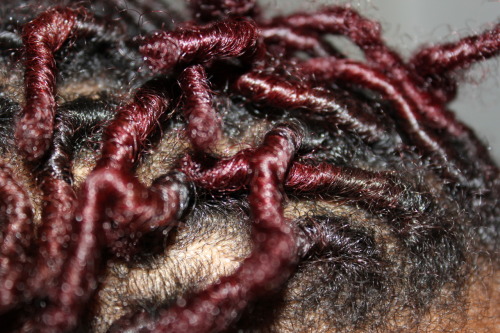As far as my research has taken me I have decided on the comb coil method to begin my very own dreadlocks. I chose this method based on the results I have seen on various other people and on my own hair type.
The choice of starter method is predominantly based on how well your hair can hold before the locking process begins and this seems dependent on hair type and length. Thick and tightly curled hair seems most likely to hold the following methods and the thinner and straighter your hair is the fewer options you may have but there IS an option for everyone and many use a combination to achieve the desired results!
If you're planning to start you're own dreadlocks take a look at the common methods used to create them:
 |
| back combing |
As seen in the picture, back combing is a method where by a fine tooth comb is used to comb sections of hair up toward to root creating tangles that can then be manipulated by either twisting or palm rolling to form a loc. Over time these tangles will matt together and firm knots will form. Rubber bands can be used to keep sections together until the matting process begins as the locs mature. Regular washing will help the process. This method works well on longer hair because more tangles can be formed.
Make sure each section is properly saturated with water and/or a water based dreadlocking product. Manipulating dry hair will cause breakage and hair loss.
Make sure each section is properly saturated with water and/or a water based dreadlocking product. Manipulating dry hair will cause breakage and hair loss.
 |
| twist and rip |
Similarly the twist and rip method creates tangles and knots by forcing two or more sections of hair to interlock together. First each section is split in to smaller sub sections and twisted together down from the root a few centimetres at a time. and then the loose hair below the twist is pulled and "ripped" apart in various directs. Each rip begins at different apoint in the section. Along with back combing this can be a very productive method for those with a looser/straighter hair texture though both methods can prove damaging if not done properly with patience and care.
Be sure to only do this on wet/lubricated hair.
Be sure to only do this on wet/lubricated hair.
 |
| freeform/neglect |
 |
| two strand twists |
If you use water and oil before starting each twist they will hold better after they have dried completely.
 |
| comb coil/finger coil |
The current trend is to use oils and/or water based products to lubricate the hair and clip each one in place before drying.
 |
| towel rub method |
There are also a variety of newer methods such as crocheting and interlocking. Do plenty of research and ask questions to find the method best for you. As a final course of action before you begin, pop into a reliable loctician* to assess which method will work with your hair type.
*A loctician is a professional hair dresser specifically trained to assess, start, maintain, style, rectify and protect dreadlocks throughout the dreading journey.
DREAD LOCKS ARE A LIFESTYLE
**I DONOT posses photography ownership or creator rights. Photography ownership or creator rights are held with the person(s) photographed and photographer**

No comments:
Post a Comment